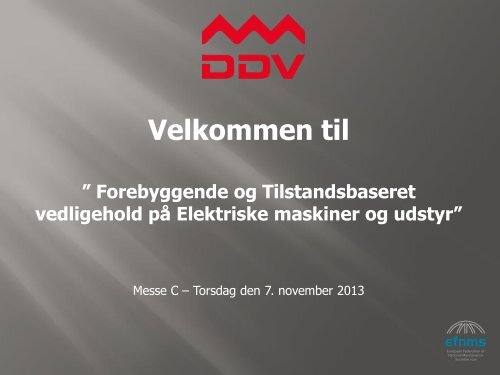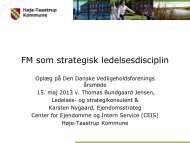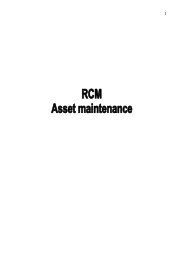Dias nummer 1 - DDV
Dias nummer 1 - DDV
Dias nummer 1 - DDV
Create successful ePaper yourself
Turn your PDF publications into a flip-book with our unique Google optimized e-Paper software.
Velkommen til<br />
” Forebyggende og Tilstandsbaseret<br />
vedligehold på Elektriske maskiner og udstyr”<br />
Messe C – Torsdag den 7. november 2013
Svend Aage West<br />
‣Senior Consultant at Vesko from 2010 to 2012.<br />
‣Senior Consultant at Centre of Asset Maintenance Management from 2009 - 2010<br />
‣Educated as fitter and mechanic in 1966.<br />
‣Educated as Marine Engineer in 1969.<br />
‣Had been Rector at Fredericia Marine Engineering college from 1984 to 2006.<br />
‣Had developed and been manager at Centre of Asset Maintenance management I<br />
Denmark from 2006 to 2009.<br />
‣Had been member of member of European Certification Committee in EFNMS from<br />
1996 to 2000.<br />
‣Had been member of European Training Committee in EFNMS from 2000 to 2008 .<br />
‣Had written many articles and papers about maintenance. The latest one is the most<br />
used maintenance book in Danish (505 pages).<br />
‣ Redaktør og forfatter på Handbook for Maskinmestre (1620 pages).<br />
‣ Co-writer to the English book: Asset Maintenance Management.<br />
‣Main developer of Maintenance Management education in Denmark<br />
‣Chairman of the presidium of the Danish Maintenance Society from 2007.<br />
‣The Danish representative in European federation for National Maintenance<br />
Societies (EFNMS) from 1995.<br />
‣Member of the steering committee of World Maintenance Forum.<br />
‣Member of the Health, Safety and Environment committee in EFNMS from 2009.<br />
Chairman from 2012 to ...
Vedligehold<br />
Kritikalitet<br />
Afhjælpende<br />
Forebyggende<br />
Ubevidst havari<br />
Bevidst havari<br />
Forudsigelig vedligehold:<br />
Tilstandsbaseret vedligehold, som<br />
udføres med baggrund i<br />
forudberegninger af analyser og<br />
evalueringer af væsentlige<br />
parametre for enhedens<br />
tilstandsudvikling.<br />
(DS/EN 13306:2010)<br />
Forudbestemt<br />
Time-, kalender-,<br />
tællerbaseret mv.<br />
Forudsigelig<br />
Driftsbetinget ved:<br />
Tilstandskontrol,<br />
Produktkvalitet,<br />
Primære parametre,<br />
Menneskelige sanser
”Fejl”<br />
Potentiel fejl:<br />
Vibrationsanalyse<br />
Potentiel fejl:<br />
Olieanalyse<br />
Potentiel fejl:<br />
Bredbånd/SPM<br />
Potentiel fejl:<br />
Temperatur<br />
Potentiel fejl:<br />
Støj<br />
Tiden<br />
Funktionel fejl
ISO 17359
Øvrige standarder<br />
samt<br />
vejledninger
ISO <strong>nummer</strong><br />
ISO 10814<br />
ISO 10816-1<br />
ISO 10816-2<br />
ISO 10816-3<br />
ISO 10816-4<br />
ISO 10816-5<br />
ISO 10816-6<br />
ISO 10817-1<br />
ISO 11342<br />
ISO 13372<br />
ISO 13373-1<br />
ISO 13373-2<br />
ISO 13374-1<br />
ISO 13374-2<br />
Standard titel<br />
Mechanical vibration — Susceptibility and sensitivity of machines to unbalance<br />
Mechanical vibration — Evaluation of machine vibration by measurements on<br />
non-rotating parts — Part 1: General guidelines<br />
Mechanical vibration — Evaluation of machine vibration by measurements on<br />
non-rotating parts — Part 2: Land-based steam turbines and generators in excess<br />
of 50 MW with normal operating speeds of 1500 r/min, 1800 r/min, 3000 r/min<br />
and 3600 r/min<br />
Mechanical vibration — Evaluation of machine vibration by measurements on<br />
non-rotating parts — Part 3: Industrial machines with nominal power above 15<br />
kW and nominal speeds between 120 r/min and 15 000 r/min when measured in<br />
situ<br />
Mechanical vibration — Evaluation of machine vibration by measurements on<br />
non-rotating parts — Part 4: Gas turbine driven sets excluding aircraft derivatives<br />
Mechanical vibration — Evaluation of machine vibration by measurements on<br />
non-rotating parts — Part 5: Machine sets in hydraulic power generating and<br />
pumping plants<br />
Mechanical vibration — Evaluation of machine vibration by measurements on<br />
non-rotating parts — Part 6: Reciprocating machines with power ratings above 100<br />
kW<br />
Rotating shaft vibration measuring systems — Part 1: Relative and absolute<br />
sensing of radial vibration<br />
Mechanical vibration — Methods and criteria for the mechanical balancing of<br />
flexible rotors<br />
Condition monitoring and diagnostics of machines -- Vocabulary<br />
Condition monitoring and diagnostics of machines — Vibration condition<br />
monitoring — Part 1: General procedures<br />
Condition monitoring and diagnostics of machines -- Vibration condition<br />
monitoring -- Part 2: Processing, analysis and presentation of vibration data<br />
Condition monitoring and diagnostics of machines -- Data processing,<br />
communication and presentation -- Part 1: General guidelines<br />
Condition monitoring and diagnostics of machines -- Data processing,<br />
communication and presentation -- Part 2: Data processing
ISO 13379<br />
ISO 13380<br />
ISO 13381-1<br />
ISO 14694<br />
ISO 14695<br />
ISO 1680<br />
ISO 17359<br />
ISO 18434-1<br />
ISO 18436-1<br />
ISO 18436-2<br />
ISO 18436-3<br />
ISO 18436-4<br />
ISO 18436-6<br />
ISO 18436-7<br />
ISO 1925<br />
ISO 1940-1<br />
ISO 1940-2<br />
ISO 1996-1<br />
ISO 1996-2<br />
ISO 2017-1<br />
Condition monitoring and diagnostics of machines -- General guidelines on data interpretation and<br />
diagnostics techniques<br />
Condition monitoring and diagnostics of machines -- General guidelines on using performance<br />
parameters<br />
Condition monitoring and diagnostics of machines -- Prognostics -- Part 1: General guidelines<br />
Industrial fans — Specifications for balance quality and vibration levels<br />
Industrial fans — Method of measurement of fan vibration<br />
Acoustics -- Test code for the measurement of airborne noise emitted by rotating electrical machines<br />
Condition monitoring and diagnostics of machines -- General guidelines<br />
Condition monitoring and diagnostics of machines -- Thermography -- Part 1: General procedures<br />
Condition monitoring and diagnostics of machines — Requirements for training and certification of<br />
personnel — Part 1: Requirements for certifying bodies and the certification process<br />
Condition monitoring and diagnostics of machines -- Requirements for training and certification of<br />
personnel -- Part 2: Vibration condition monitoring and diagnostics<br />
Condition monitoring and diagnostics of machines -- Requirements for qualification and assessment of<br />
personnel -- Part 3: Requirements for training bodies and the training process<br />
Condition monitoring and diagnostics of machines -- Requirements for qualification and assessment of<br />
personnel -- Part 4: Field lubricant analysis<br />
Condition monitoring and diagnostics of machines -- Requirements for qualification and assessment of<br />
personnel -- Part 6: Acoustic emission<br />
Condition monitoring and diagnostics of machines -- Requirements for qualification and assessment of<br />
personnel -- Part 7: Thermography<br />
Mechanical vibration — Balancing — Vocabulary<br />
Mechanical vibration — Balance quality requirements of rigid rotors — Part 1: Specification and<br />
verification of balance tolerances<br />
Mechanical vibration — Balance quality requirements of rigid rotors — Part 2: Balance errors<br />
Acoustics -- Description, measurement and assessment of environmental noise -- Part 1: Basic quantities<br />
and assessment procedures<br />
Acoustics -- Description, measurement and assessment of environmental noise -- Part 2: Determination of<br />
environmental noise levels<br />
Mechanical vibration and shock — Resilient mounting systems — Part 1: Application of source and<br />
receiver isolation
ISO 2041<br />
ISO 22266-1<br />
ISO 2314<br />
ISO 2954<br />
ISO 3945<br />
ISO 4867<br />
ISO 5348<br />
ISO 5348<br />
Vibration and shock — Vocabulary<br />
Mechanical vibration -- Torsional vibration of rotating machinery -- Part 1: Land-based steam<br />
and gas turbine generator sets in excess of 50 MW<br />
Gas turbines - Acceptance tests<br />
Mechanical vibration of rotating and reciprocating machinery — Requirements for instruments<br />
for measuring vibration severity<br />
Mechanical vibration of large<br />
rotating machines with speed range from 10 to 200 r/s. Measurement and evaluation of<br />
vibration severity in situ.<br />
Code for the measurement and reporting of shipboard vibration data<br />
Mechanical vibration and shock — Mechanical mounting of accelerometers<br />
Mechanical vibration and shock -- Mechanical mounting of accelerometers<br />
ISO 7626-1<br />
Vibration and shock — Experimental determination of mechanical mobility — Part 1: Basic<br />
definitions and transducers<br />
ISO 7626-2 Vibration and shock — Experimental determination of mechanical mobility — Part 2:<br />
Measurements using single-point translation excitation with an attached vibration exciter<br />
ISO 7626-5 Vibration and shock — Experimental determination of mechanical mobility — Part 5:<br />
Measurements using impact excitation with an exciter which is not attached to the structure<br />
ISO 7919-1<br />
ISO 7919-2<br />
ISO 7919-3<br />
ISO 7919-4<br />
ISO 7919-5<br />
ISO 8297<br />
Mechanical vibration of non-reciprocating machines — Measurement on rotating shafts and<br />
evaluation criteria — Part 1: General guidelines<br />
Mechanical vibration — Evaluation of machine vibration by measurements on rotating shafts<br />
— Part 2: Land-based steam turbines and generators in excess of 50 MW with normal operating<br />
speeds of 1 500 r/min, 1 800 r/min, 3 000 r/min and 3 600 r/min<br />
Mechanical vibration of non-reciprocating machines — Measurements on rotating shafts and<br />
evaluation criteria — Part 3: Coupled industrial machines<br />
Mechanical vibration of non-reciprocating machines — Measurements on rotating shafts and<br />
evaluation criteria — Part 4: Gas turbine sets<br />
Mechanical vibration of non-reciprocating machines — Measurements on rotating shafts and<br />
evaluation criteria — Part 5: Machine sets in hydraulic power generating and pumping plants<br />
Acoustics. Determination of sound power levels of multi-source industrial plants for the<br />
evaluation of the sound pressure levels in the environment. Engineering method.
ISO 8528-9<br />
Reciprocating internal combustion engine driven alternating current generating<br />
sets — Part 9: Measurement and evaluation of mechanical vibrations<br />
ISO 8569<br />
ISO 8626<br />
ISO 8821<br />
ISO22096<br />
ISO8579-2<br />
Mechanical vibration and shock -- Measurement and evaluation of shock and<br />
vibration effects on sensitive equipment in buildings<br />
Servo-hydraulic test equipment for generating vibration -- Method of describing<br />
characteristics<br />
Mechanical vibration — Balancing — Shaft and fitment key convention<br />
Condition monitoring and diagnostics of machines -- Acoustic emission<br />
Acceptance code for gears — Part 2: Determination of mechanical vibrations of gear<br />
units during acceptance testing
EN <strong>nummer</strong><br />
Standard titel<br />
EN 13269<br />
EN 13306<br />
DS/EN 13306:2009<br />
EN 13460<br />
DS/EN 13460:2009<br />
EN 15341<br />
DS/EN 15341:2010<br />
EN 61703<br />
EN 60300-3-1<br />
EN 60034-14<br />
CEN/TR 15628:2007<br />
Maintenance - Guideline on preparation of maintenance contracts<br />
Maintenance terminology<br />
Vedligehold-Terminologi<br />
Maintenance – Documents for maintenance<br />
Vedligehold-Dokumentation for vedligehold<br />
Maintenance – Maintenance Key Performance Indicators<br />
KPIer for vedligehold<br />
Mathematical expressions for reliability, availability, maintainability and<br />
maintenace support terms<br />
Dependability management. Part 3-1: Application guide. Analysis<br />
techniques for dependability. Guide on methodology<br />
Rotating electrical machines. Part 14: Mechanical vibration of certain<br />
machines with shaft heights 56 mm and higer. Measurements, evaluation<br />
and limits of vibration<br />
Maintenance - Qualification of Maintenance personnel<br />
CEN/TS 15331:2005<br />
Criteria for design, management and control of maintenance services for<br />
buildings
IEC <strong>nummer</strong><br />
IEC 60300-1<br />
IEC 60300-2<br />
IEC 60300-3-1<br />
IEC 60300-3-2<br />
IEC 60300-3-3<br />
IEC 60300-3-4<br />
IEC 60300-3-6<br />
IEC 60863<br />
Standard titel<br />
Dependability management – Part 1: Dependability programme management<br />
Dependability management – Part 2: Dependability programme elements and tasks<br />
Dependability management – Part 3: Application guide – Section 1: Analysis techniques for dependability:<br />
Guide on methodology<br />
Dependability management – Part 3: Application guide – Section 2: Collection of dependability data from the<br />
field<br />
Dependability management – Part 3: Application guide – Section 3: Life cycle costing<br />
Dependability management – Part 3: Application guide – Section 4: Guide to the specification of<br />
dependability requirements<br />
Dependability management – Part 3: Application guide – Section 6: Software aspects of dependability<br />
Presentation of reliability, maintainability and availability predictions<br />
IEC 61160<br />
IEC 61703<br />
IEC 61713<br />
IEC 61882<br />
IEC 62309<br />
IEC 61014<br />
IEC 60300-3-10<br />
IEC 60706-1<br />
IEC 60706-2<br />
IEC 60706-3<br />
IEC 60706-5<br />
IEC 60300-3-11<br />
IEC 60300-3-12<br />
IEC 60300-3-14<br />
IEC 60706-4<br />
IEC 60300-3-9<br />
IEC 62198<br />
Formal design review<br />
Mathematical expressions for reliability, availability, maintainability and maintenance support terms<br />
Software dependability through the software life cycle processes – Application guide<br />
Hazard and operability studies (HAZOP studies) – Application guide<br />
Dependability and quality of products declared "as new" – Requirements and tests<br />
Programmes for reliability growth<br />
Dependability management – Part 3-10: Application guide – Maintainability<br />
Guide on maintainability of equipment – Part 1: Sections 1, 2 and 3. Introduction, requirements and<br />
maintainability programme<br />
Guide on maintainability of equipment – Part 2: Section 5: Maintainability studies during the design phase<br />
Guide on maintainability of equipment – Part 3: Sections 6 and 7: Verification and collection, analysis and<br />
presentation of data<br />
Guide on maintainability of equipment – Part 5: Testability and Diagnostic testing<br />
Dependability management – Part 3-11: Application guide – Reliability Centred Maintenance<br />
Dependability management – Part 3-12: Application guide – Integrated logistics support<br />
Dependability management – Part 3-14: Application guide – Maintenance and maintenance support<br />
Guide on maintainability of equipment – Part 4: Section 8: Maintenance and maintenance support planning<br />
Dependability management – Part 3: Application guide – Section 9: Risk analysis of technological systems<br />
Project risk management – Application guidelines
IEC <strong>nummer</strong><br />
IEC 60300-1<br />
IEC 60300-2<br />
IEC 60300-3-1<br />
IEC 60300-3-2<br />
IEC 60300-3-3<br />
IEC 60300-3-4<br />
IEC 60300-3-6<br />
IEC 60863<br />
IEC 61160<br />
IEC 61703<br />
IEC 61713<br />
IEC 61882<br />
IEC 62309<br />
IEC 61014<br />
IEC 60300-3-10<br />
IEC 60706-1<br />
IEC 60706-2<br />
IEC 60706-3<br />
IEC 60706-5<br />
IEC 60300-3-11<br />
IEC 60300-3-12<br />
IEC 60300-3-14<br />
IEC 60706-4<br />
IEC 60300-3-9<br />
IEC 62198<br />
Standard titel<br />
Dependability management – Part 1: Dependability programme management<br />
Dependability management – Part 2: Dependability programme elements and tasks<br />
Dependability management – Part 3: Application guide – Section 1: Analysis techniques for dependability:<br />
Guide on methodology<br />
Dependability management – Part 3: Application guide – Section 2: Collection of dependability data from the<br />
field<br />
Dependability management – Part 3: Application guide – Section 3: Life cycle costing<br />
Dependability management – Part 3: Application guide – Section 4: Guide to the specification of<br />
dependability requirements<br />
Dependability management – Part 3: Application guide – Section 6: Software aspects of dependability<br />
Presentation of reliability, maintainability and availability predictions<br />
Formal design review<br />
Mathematical expressions for reliability, availability, maintainability and maintenance support terms<br />
Software dependability through the software life cycle processes – Application guide<br />
Hazard and operability studies (HAZOP studies) – Application guide<br />
Dependability and quality of products declared "as new" – Requirements and tests<br />
Programmes for reliability growth<br />
Dependability management – Part 3-10: Application guide – Maintainability<br />
Guide on maintainability of equipment – Part 1: Sections 1, 2 and 3. Introduction, requirements and<br />
maintainability programme<br />
Guide on maintainability of equipment – Part 2: Section 5: Maintainability studies during the design phase<br />
Guide on maintainability of equipment – Part 3: Sections 6 and 7: Verification and collection, analysis and<br />
presentation of data<br />
Guide on maintainability of equipment – Part 5: Testability and Diagnostic testing<br />
Dependability management – Part 3-11: Application guide – Reliability Centred Maintenance<br />
Dependability management – Part 3-12: Application guide – Integrated logistics support<br />
Dependability management – Part 3-14: Application guide – Maintenance and maintenance support<br />
Guide on maintainability of equipment – Part 4: Section 8: Maintenance and maintenance support planning<br />
Dependability management – Part 3: Application guide – Section 9: Risk analysis of technological systems<br />
Project risk management – Application guidelines
IEC 61163-2<br />
IEC 61163-3<br />
IEC 61164<br />
IEC 61165<br />
IEC 61649<br />
IEC 61650<br />
IEC 61709<br />
IEC 61710<br />
IEC 61810-1<br />
IEC 61810-2<br />
IEC 62059-31<br />
IEC 62308<br />
IEC 62429<br />
IEC 60706-6<br />
IEC 60410<br />
IEC 60300-3-16<br />
IEC 61882<br />
IEC 62402<br />
Reliability stress screening – Part 2: Electronic components<br />
Reliability stress screening – Part 3: Repairable single items (NWIP)<br />
Reliability growth – Statistical test and estimation methods<br />
Application of Markov techniques<br />
Goodness-of-fit tests, confidence intervals and lower confidence limits for<br />
Weibull distributed data<br />
Reliability data analysis techniques – Procedures for the comparison of two<br />
constant failure rates and two constant failure (event) intensities<br />
Electronic components – Reliability – Reference conditions for failure rates and<br />
stress models for conversion<br />
Power law model – Goodness-of-fit tests and estimation methods<br />
Electromechanical elementary relay - Part 1: General and safety requirements<br />
Electromechanical elementary relay - Part 2: Reliability<br />
Electricity metering equipment (a.c.) - Dependability - Part 31: Accelerated<br />
reliability testing<br />
Reliability assessment methods<br />
Reliability growth - Stress testing for early failures in unique complex systems<br />
Guide on maintainability of equipment – Part 6: Section 9: Statistical methods in<br />
maintainability evaluation<br />
Sampling plans and procedures for inspection by attributes<br />
Dependability management - Part 3-16: Application guide - Guideline for the<br />
specification of maintenance support services<br />
Hazard and operability studies (HAZOP studies) - Application guide<br />
Obsolescence management - Application guide





